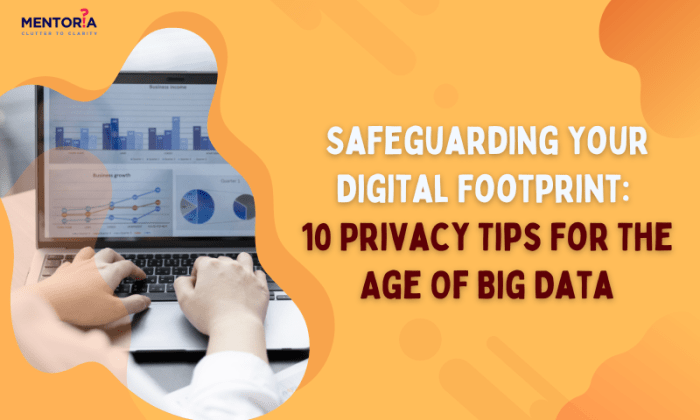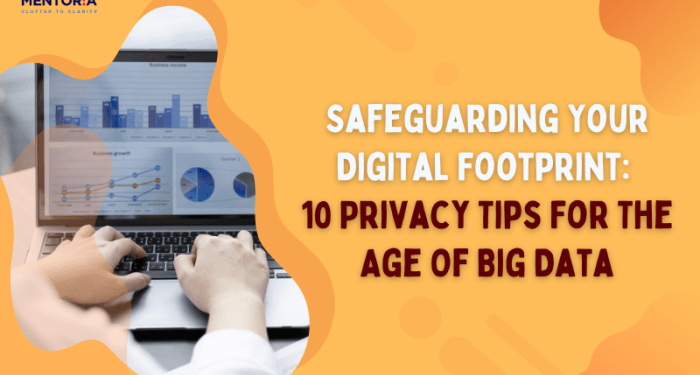Embark on a journey to safeguard your digital presence with these Privacy tips for protecting your digital footprint. In a world where our online activities leave lasting imprints, it's crucial to take proactive steps to secure our digital identities. Let's dive into the realm of digital privacy and explore ways to shield ourselves from potential risks and threats.
Introduction to Digital Footprint Protection

A digital footprint refers to the trail of data left behind by an individual's online activity. This includes information shared on social media, browsing history, online purchases, and more.
It is crucial to protect your digital footprint to safeguard your privacy and personal information. Without proper protection, this data can be exploited by cybercriminals for malicious purposes.
Potential Risks of an Unprotected Digital Footprint
- Identity Theft: Cybercriminals can use your digital footprint to steal your identity and commit fraud in your name.
- Online Reputation Damage: Inappropriate posts or comments online can harm your reputation and affect your personal and professional life.
- Targeted Advertising: Companies can use your digital footprint to target you with personalized ads, invading your privacy.
- Data Breaches: Unprotected digital footprints are vulnerable to data breaches, leading to the exposure of sensitive information.
Best Practices for Protecting Your Digital Footprint
When it comes to safeguarding your digital presence, there are several best practices that can help you maintain your privacy and security online.
Using Strong, Unique Passwords
One of the most crucial steps in protecting your digital footprint is using strong, unique passwords for all your online accounts. Avoid using easily guessable passwords such as "123456" or "password." Instead, create complex passwords consisting of a mix of letters, numbers, and special characters.
Enabling Two-Factor Authentication
Two-factor authentication adds an extra layer of security to your accounts by requiring a second form of verification, such as a code sent to your phone or email, in addition to your password. This significantly reduces the risk of unauthorized access even if your password is compromised.
Regular Software Updates
Regularly updating your software, including operating systems, web browsers, and applications, is essential for protecting your digital footprint. Software updates often contain patches for security vulnerabilities that cybercriminals can exploit to gain access to your data. By staying up to date with software updates, you can reduce the risk of falling victim to cyber attacks.
Social Media Privacy Settings
Maintaining your privacy on social media is crucial in protecting your digital footprint. By adjusting your privacy settings and being mindful of the information you share, you can control who has access to your personal data.
Adjusting Privacy Settings on Social Media Platforms
- Review the privacy settings on each of your social media accounts regularly.
- Customize your privacy settings to limit who can see your posts, profile information, and contact details.
- Consider making your accounts private to only allow approved followers or friends to view your content.
- Disable location services and geotagging features that reveal your exact whereabouts.
Limiting Information Visible to the Public
- Avoid sharing sensitive personal information such as your home address, phone number, or financial details.
- Be cautious about posting your daily routine or vacation plans as it can make you vulnerable to theft or stalking.
- Think twice before accepting friend requests from strangers or unknown accounts.
- Regularly review your tagged photos and posts to ensure they align with your privacy preferences.
Implications of Geotagging and Location Sharing
- Geotagging your posts or sharing your location can reveal your current or frequent whereabouts to potentially malicious individuals.
- Consider the risks of broadcasting your location in real-time, especially if you are in unfamiliar or public settings.
- Disable geotagging features on your social media accounts to prevent others from tracking your movements.
- Be mindful of the implications of sharing your location, as it can compromise your safety and privacy.
Online Data Tracking and Cookies
Online Data Tracking and Cookies play a significant role in how websites collect and analyze user information. Websites often use cookies to track user activity, personalize content, and provide a better browsing experience. However, this practice raises concerns about privacy and data security.
Understanding how websites track user data through cookies and knowing how to manage and delete cookies from browsers is essential for protecting your digital footprint.
Managing and Deleting Cookies
Cookies are small text files that websites store on your device to track your browsing behavior. While cookies can be helpful in remembering your preferences and login information, they can also be used to track your online activities across different websites.
To manage and delete cookies from your browser, follow these steps:
- For Google Chrome:
- Click on the three dots in the top-right corner and select "Settings."
- Scroll down and click on "Advanced" to expand the menu.
- Under "Privacy and security," click on "Clear browsing data."
- Select the time range and check the box next to "Cookies and other site data."
- Click on "Clear data" to delete cookies from your browser.
- For Mozilla Firefox:
- Click on the three horizontal lines in the top-right corner and select "Options."
- Go to the "Privacy & Security" tab.
- Scroll down to the "Cookies and Site Data" section.
- Click on "Clear Data" to remove cookies from your browser.
- For Safari:
- Go to the Safari menu and select "Preferences."
- Click on the "Privacy" tab.
- Click on "Manage Website Data" to view and remove cookies.
Private Browsing Modes
Using private browsing modes, such as Chrome's Incognito mode or Firefox's Private Browsing mode, can help reduce tracking by preventing websites from storing cookies on your device. When browsing in private mode, your browsing history, cookies, and site data are not saved, providing a more anonymous browsing experience.
Remember to enable private browsing mode when visiting websites that you do not want to track your online activities.
Securing Personal Devices
When it comes to protecting your digital footprint, securing personal devices is crucial. By implementing necessary measures, you can prevent unauthorized access to your personal information and ensure the safety of your data.
Importance of Antivirus Software and Firewalls
Antivirus software and firewalls act as the first line of defense against cyber threats. Antivirus software helps detect and remove malware, while firewalls monitor and control incoming and outgoing network traffic. It is essential to keep both updated regularly to safeguard your devices from potential security breaches.
Tips for Securing Smartphones and Tablets
- Set up a strong passcode or biometric authentication, such as fingerprint or face recognition, to prevent unauthorized access to your device.
- Enable encryption on your device to protect your data in case it falls into the wrong hands.
Importance of Regular Data Backup
Regularly backing up your data is crucial in preventing data loss due to device theft, damage, or malware attacks. By creating backups either on external drives or cloud storage, you can ensure that your important information remains safe and accessible even in the event of unexpected incidents.
Email and Messaging Security
When it comes to protecting your digital footprint, email and messaging security play a crucial role in safeguarding your personal information. Cyber criminals often use phishing attacks and email scams to trick individuals into sharing sensitive data or downloading malicious software.
It is essential to be vigilant and take precautions to avoid falling victim to these online threats.
Risks of Phishing Attacks and Email Scams
Phishing attacks involve fraudulent emails or messages that appear to be from reputable sources, such as banks or government agencies, prompting recipients to provide personal information like passwords, credit card details, or social security numbers. These scams can lead to identity theft, financial loss, or unauthorized access to your accounts.
- Be wary of emails requesting urgent action or threatening consequences if you do not comply.
- Avoid clicking on links or downloading attachments from unknown senders.
- Verify the legitimacy of the sender's email address and look out for any spelling errors or inconsistencies in the message.
Recognizing and Avoiding Suspicious Emails or Messages
It is crucial to be able to identify and steer clear of suspicious emails or messages to protect your personal information and privacy online. By staying vigilant and following best practices, you can reduce the risk of falling victim to phishing scams and email fraud.
- Check the sender's email address and domain to ensure it matches the official website of the supposed sender.
- Avoid providing sensitive information like passwords, social security numbers, or financial details through email.
- Do not reply to or engage with unsolicited messages requesting personal information or financial assistance.
Importance of Encrypting Sensitive Communications
Encrypting sensitive communications adds an extra layer of security to your emails and messages, ensuring that only the intended recipient can access and decipher the information. By using secure communication protocols and encryption tools, you can protect the confidentiality and integrity of your online conversations.
Encrypting your emails and messages can prevent unauthorized access and eavesdropping, safeguarding your sensitive data from cyber threats and malicious actors.
Final Conclusion
As we conclude our discussion on Privacy tips for protecting your digital footprint, remember that every click, post, or share contributes to your digital footprint. By implementing these strategies and staying vigilant, you can navigate the digital landscape with confidence and control over your online identity.
Safeguard your digital presence, one step at a time.
Detailed FAQs
How can I manage my online data tracking effectively?
To manage online data tracking, regularly clear your browser cookies, use private browsing modes, and consider browser extensions that enhance privacy.
Why is encrypting sensitive communications important?
Encrypting sensitive communications ensures that your messages are secure and protected from unauthorized access, maintaining your privacy and confidentiality.






